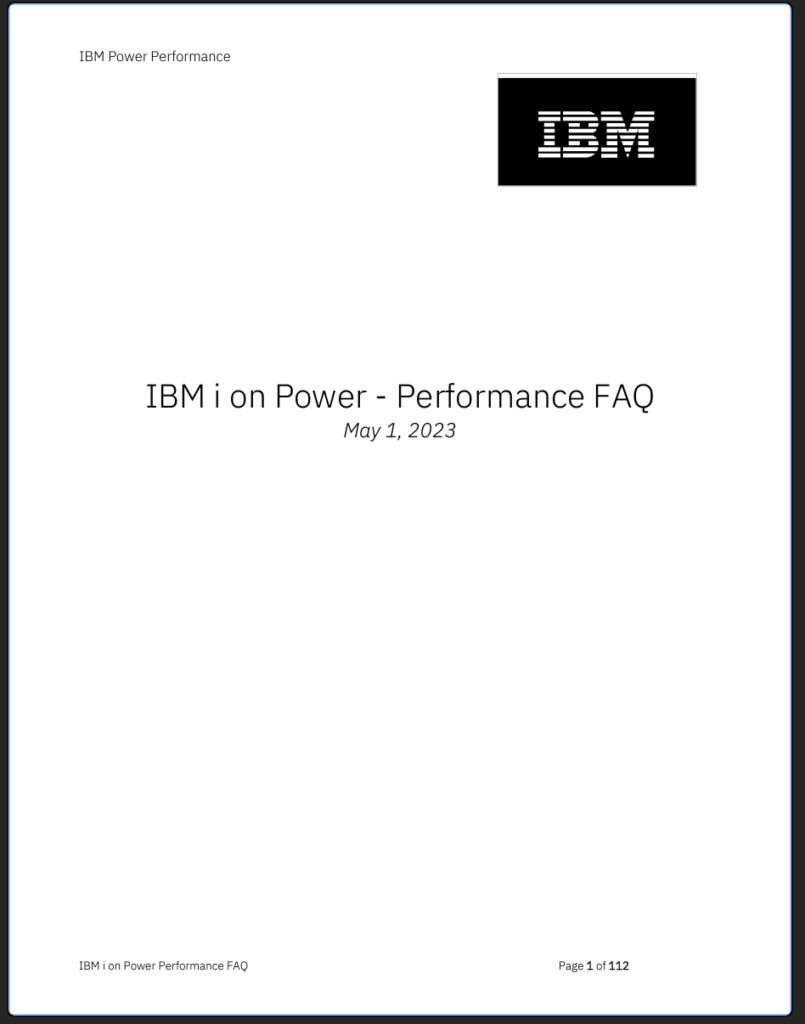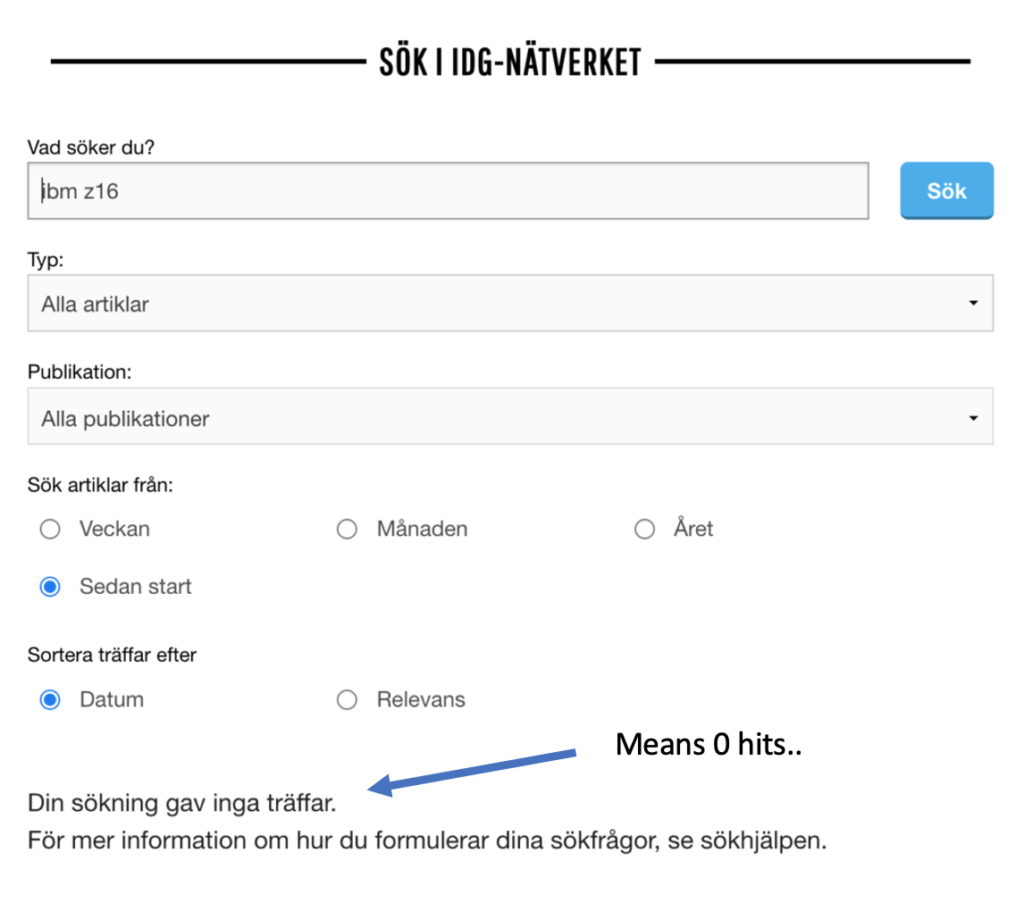“This document is intended to address most frequently asked questions concerning IBM i performance on Power and provide best practice guidelines for most commonly seen performance issues.”
Download here: https://www.ibm.com/downloads/cas/QWXA9XKN

“This document is intended to address most frequently asked questions concerning IBM i performance on Power and provide best practice guidelines for most commonly seen performance issues.”
Download here: https://www.ibm.com/downloads/cas/QWXA9XKN


Dear Manager,
As you know, I am always striving towards more efficiency and tries to do things smarter to make our business even more successful. Therefore I would like to get permission to go to XYZ Conference (Why not Common Europe Congress) in the month of XYZ (Say June 2023).
At this conference I will have the best chances to meet real experts in my field. Learn from them, hear about how other companies are using the latest technologies to solve issues we are still struggling with. People at these conferences are the best in sharing their own experiences and warning for pitfalls to avoid for us to save time and money. This is of course difficult to make a return of investment on, but as you know, experts like them charge 150 – 200 Euro/USD per hour normally.
There will be vendors of very good solutions attending the conference as sponsors as well. We are using tools from Company A + Company B + Company C already today, I will talk to them of course but also visit the expo area to find out if there are other tools or solutions we should consider using.

I’ve went through the draft conference agenda, and here is a list of sessions I will attend for sure If I get there:
You can count on me making a presentation to show at the next group meeting when I am back home again. In this presentation I will go through the best findings from the conference and also give some inspiration to my colleagues. The whole team will grow stronger because of this.

Besides all the benefit our company gains from this educational event. I will grow as a person, get new insights and probably make some new friends, some of them for life even. After all, to not let us educate ourselves about the technologies we are already using, is similar to buying a truck without giving people the driving license for it.
The total investment from you would be:
I am looking forward your positive response
Thank you

(the original article can be found HERE)
“We are leaving the platform, because we cannot find RPG programmers” I am sick and tired of this comment. For me this is pure BS and I will tell you why.
First of all, to be a bit more humble, if you are still running RPGII and RPGIII code from 1970s and 1980s you might be correct (It is awesome you can still run this on completely different and hyper modern hardware architecture that would have blown the programmer away when the code was written). You will even find it impossible to get someone who wants to learn those versions (even if I have a very inspiring example when this happened and they are now using AI in the modernised RPG application). Learn, yes people are still interested in learning things such as MODERN programming languages where Full Free Form RPG is one of them. Remember new programming languages comes out every now and then and people learn how to program in them.

To be successful you therefore need to do your homework and give the developers an environment that is attractive to them. Most likely you have a pretty cool business to support with the application already, IBM i is always involved in business critical stuff after all. Btw, an attractive environment for developers today includes modern IDE’s, open source and modern tooling like Git based stuff. I hope I don’t have to remind you that SQL should be your other No1 programming language. It is time jump off the steam locomotive and jump on the high speed train that is on the same platform.
Learn modern RPG is not difficult for a decent smart person. To learn your or your clients business though is often the tricky part. If you have other developers in house already who knows at least the basics of your “business logic” I would start by reaching out to them. If you hired people with the right attitude and curiosity to begin with they will say H*LL YEAH!

By the way, like Paul Tuohy (the picture is not of his best side should be mentioned) says there are two kinds of programmers. Maintenance programers and business application developers. You should most likely to go for the latter. Well, not if you are still looking for a RPGII person perhaps 🙂
“No schools educate people in RPG”, is another comment I virtually punch people in the face when I hear. One reason is because this is not true, the second reason is I rarely hear companies in the need of programming skills in R, D, Rust, Go or any new programming language crying out the same complaints. Instead they are reaching out to schools and companies learning these languages or just put courses up themselves if they have the resources, like Asseco PST in Portugal or Sanmarco Informatica in Italy.
Therefore I have put together a list of alternatives for you (Thank you Michael Mayer for your list on your great site https://ibmireference.blogspot.com for a number of links) when you are planning for the future of your IBM i application.
IBM Education (still around and updated)






In Europe you have a number of local provides teaching in their native (speaking) language as well.



There are also hundreds of smaller firms helping out if needed.

And my own little hobby www.ibmicompetence.com


Now repeat after me

I have a question. Why is IBM i (ignorant people still calls it AS/400, iSeries or other old names..) seen as an outdated platform for running business applications by some?
Is it the green screen “5250” user interface? It must still be the 5250 user interface that was such a success factor in the 1970-1990s but quickly became a burden for the platform once Apple and Microsoft came with nice and shiny colourful alternatives 25-30 years ago… Are people that stupid and cannot se the greatness beyond that even today when the preferred UI for end users are built on javascript.
Even 5250 is more sophisticated than all other system admin interfaces on the planet. But let’s focus on the extremely innovative system IBM i in this article… To do that we have to go back to the early 1970’s or even a bit before that.

From the book “Inside the AS/400” by Chief Architect Frank Soltis : “During the 1960s, MIT engineers and computer scientists worked on a department of Defense project called MULTICS. Companies such as Digital, Data General and IBM’s New York laboratories hired graduates from MIT and other eastern universities. The computers and operating systems designed at these companies borrowed much from projects such as MULTICS. The Unix operating system from Bell Laboratories came out of this environment. Because designs from these companies were variations on the same themes, they pretty much looked alike. It was highly unlikely that a revolutionary new design would ever come from one of these facilities. The IBM i (AS/400 in the book)history is very different…”
It was highly unlikely that a revolutionary new design would ever come from one of these facilities. The IBM i (AS/400 in the book)history is very different
So, already now we know that IBM i is the most innovative operating system on the planet not just a copy past of ideas from the same source. But it will be better. Let’s read more in that brilliant book.
“In the late 1960s and early 1970s, IBM considered a radical redesign of their entire product line to take advantage of the much lower cost of computer circuitry expected in the 1980s. The major objectives of the FS project were consequently stated as follows:
It was hoped that a new architecture making a heavier use of hardware resources, the cost of which was going down, could significantly simplify software development and reduce costs for both IBM and customers“
The project failed because of several reasons, but many of the innovative ideas and concepts used in that project ended up in IBM i via System/38, AS/400, iSeries, System i…
IBM i has been mocked by competitors since the 1990’s, not at least from Microsoft. But after a bit googling, I can say it was because they were jealous and nothing more. Well, they were obviously very pleased that the majority looked only at the GUI layer when they decided where to put their business applications. This alone was their success if you ask me..
One of the most innovative technologies that even defines the operating system (which is much more than an operating system) is the built in relational database. I repeat, built into the operating system. Cannot be removed (doesn’t have to be installed either..) and this is the native file system if you would like. You install IBM i, logging in with the supersmart 5250 interface and you type CRTTBL and the TaBLe is CReaTed (you don’t have to be a rocket scientist to understand the command structure of the system). How cool isn’t that?? There are good reasons why you should create your schemas etc with better interfaces but we leave that out in this article.
You install IBM i, logging in with the supersmart 5250 interface and you type CRTTBL and the TaBLe is CReaTed (you don’t have to be a rocket scientist to understand the command structure of the system). How cool isn’t that??
If it is that cool, why didn’t the competition do the same thing in their solutions?? Well they tried but it is not so very easy if you don’t have the smartest people on the earth as IBM had.
“WinFS (short for Windows Future Storage) was the code name for a canceled data storage and management system project based on relational databases, developed by Microsoft and first demonstrated in 2003 as an advanced storage subsystem for the Microsoft Windows operating system, designed for persistence and management of structured, semi-structured and unstructured data. WinFS includes a relational database for storage of information, and allows any type of information to be stored in it, provided there is a well defined schema for the type.”

“Before it’s time”hahahahaaaaa… Bill old Bill…
Ok, what else. Oh yeees! This one is good.
Single Level Storage (or somethings just Store) This is a brilliant technology implemented (not invented) in IBM i and Microsoft also really wanted. Really. 12 (2003-2015) years of development isn’t just a hobby project..

We shall not mock MS anymore. They are heavily under attack after all. I participated a online course by MIT earlier this year where the professors said “Microsoft probably doesn’t exist 15 years from now..”
So where does the attack comes from? Containers and “cloud native development”… This god’s solution to all problems in the IT industry. Please learn how libraries, subsystems, memory pools and objects on IBM i all work together and you will be ashamed if you thought containers were such a good idea for enterprise business applications. And ask your CFO which application architecture he or she think will be the most cost effective the next coming 3, 5 and 10 years… Be ready to invest in an IBM i environment *immed if you don’t have that already.
I stop here but could go on for another 10 pages or so. But please agree with me, the IBM i “sophisticated business application environment” deserves a better place in the IT landscape of today.
I am still waiting for Swedish IDG to publish ANYTHING about the new IBM z16 server. Z as in ZERO!!!
To the Swedish audience:
“IBM innovations, including the IBM z16, have formed the technology backbone of the global economy for decades. Today’s modern IBM mainframe is central to hybrid cloud environments, valued by two thirds of the Fortune 100, 45 of the world’s top 50 banks, 8 of the top 10 insurers, 7 of the top 10 global retailers and 8 out of the top 10 telcos as a highly secured platform for running their most mission critical workloads”
So let’s compare IDG.SE with the rest of the world..

At the same time in the big world outside of Sweden..